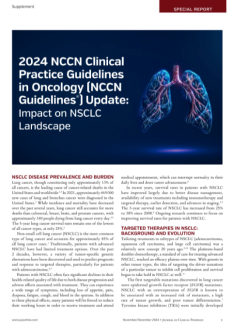Overcoming CLL Treatment Challenges With Evolving Pathways and Targeted Therapies
In this interview, Bita Fakhri, MD, MPH, discusses the evolving role of cellular therapies and novel targeted treatments in chronic lymphocytic leukemia, emphasizing the shift toward time-limited therapies to improve patient outcomes while addressing toxicity and financial burden.
Bita Fakhri, MD, MPH: I am Bita Fakhri, MD, MPH. I'm an attending physician at Stanford University and the director of the clinical trial portfolio for chronic lymphocytic leukemia (CLL) at Stanford University.
 How do you see cellular therapies evolving in the treatment landscape for hematologic malignancies, particularly for CLL?
How do you see cellular therapies evolving in the treatment landscape for hematologic malignancies, particularly for CLL?
Dr Fakhri: It's definitely a growing field. In March 2024, lisocabtagene maraleucel (liso-cel), a CD19 -directed CAR T-cell product, was approved for the double-exposed/double refractory patient population in CLL. By double-exposed/refractory, I mean patients with CLL who have been exposed and/or are refractory to both covalent Bruton tyrosine kinase (BTK) inhibitors and BCL-2 inhibitors, which is a truly unmet need in the field of CLL. This is a patient population that, in the past decade with the advent of targeted therapies in CLL, has made significant progress, but now they are getting to a point where they are not responding to the best available classes of drugs. There is going to be a rise in the double-exposed refractory patient population in the next decade. Cell-based therapies will come into play for this very specific area.
Based on the TRANSCEND CLL 004 trial, CAR T-cell therapy was approved for this population. If you look at the data, a heavily pretreated patient population with high-risk features had a median progression-free survival of 18 months, with a complete response rate of 18% and an overall response rate of 47%. At ASH 2024, we saw that the cohort which had ibrutinib plus liso-cel performed significantly better than single-agent liso-cel, which makes a lot of sense because ibrutinib enhances T-cell immunity, and when you collect enhanced T cells, the results are expected to be better.
Other cell-based therapies like bispecific T-cell engagers, particularly epcoritamab, were presented at ASH 2024. Epcoritamab is a CD3/CD20 bispecific T-cell engager. The cohort that was presented at ASH was single-agent epcoritamab in a heavily pretreated patient population with high-risk features. The overall response rate was 67% and included some patients who were previously treated with CAR T-cell therapy. Epcoritamab is being investigated in different cohorts, including in venetoclax-naïve patients where epcoritamab is combined with venetoclax. In patients who have started their CLL journey with a covalent BTK inhibitor, and experience progression, they've never seen venetoclax. Historically, we would start these patients on venetoclax plus a CD20 monoclonal antibody, but now based on the epcoritamab clinical trial, they have the opportunity to start venetoclax plus epcoritamab.
The trial is also investigating indefinite therapy with epcoritamab in the relapsed/refractory settingversus time-limited therapy approaches. Additionally, epcoritamab plus pirtobrutinib, which is the first noncovalent BTK inhibitor approved for patients with double-exposed, double-refractory CLL, is being combined with epcoritamab with the hope that the results are going to be better than each agent investigated in a singular fashion.
What challenges do you see in integrating novel targeted therapies into standard care for CLL?
Dr Fakhri: When we design clinical trials, our two main dimensions to focus on are efficacy and safety. We want to make sure that we combine different drugs with biological rationale in a way to enhance synergy and result in deeper molecular remission as measured by minimal residual disease (MRD), which will potentially translate to prolonged progression-free survival.
By combining different agents, I come back to the second dimension, which is safety. The tolerability of these molecules becomes a huge factor. If you're combining these medications, no matter how well tolerated they are individually, there is always a concern for added toxicity. We want to make sure that we find the dose level that is going to be effective, but at the same time not at the cost of toxicity for patients. We are at a place in the field of CLL where our patients have a menu of options, so it's extremely important to make sure that we introduce combinations and agents that do not make our patients miserable. Of course, every patient, when they get on a clinical trial or a combination, expects a reasonable side effect profile.
How can treatment pathways for CLL adapt to incorporate these newer therapies while balancing cost-effectiveness and patient outcomes?
Dr Fakhri: In February 2014, for the first time, ibrutinib was approved based on the RESONATE trial in patients with relapsed/refractory CLL. This is a truly transformative molecule that revolutionized the field of CLL, but covalent BTK inhibitorsadministered as single agent, are indefinite therapies, and patients are doing extremely well on them. The financial toxicities associated with the treatment in a patient who is potentially going to be on these medicines for prolonged periods of time is definitely a burden on both the patient and the payer.
The field of CLL has appreciated the financial toxicities in addition to other potential toxicities. We know that some toxicities associated with covalent BTK inhibitors that are indefinite therapies are late toxicities, like hypertension. For example, when they develop hypertension, then they're on a medicine to control their cancer for life, in addition to one or two antihypertensive medicines for the rest of their lives. The polypharmacy associated with this issue is going to be backbreaking for a lot of patients.
Because of that, our field is moving toward time-limited approaches, one or two years of treatment. The UK FLARE study had ibrutinib plus venetoclax, potentially for 6 years; that is not time-limited therapy. When we talk about time-limited therapy, we are looking at 1 to 2 years of effective, safe, and tolerable treatment options that will allow our patients to enjoy prolonged treatment-free remissions for quite some time. Our treatments have been very successful in that sense.
The CLL14 trial was the first trial in the field of CLL that introduced the concept of time-limited therapy, which was a combination of obinutuzumab plus venetoclax for 1 year. The 6-year progression-free survival for that population was 53%. I always pause and make sure that patients understand that in people who took the combination for 1 year, enjoyed a 5-year treatment-free remission, 6 years later, 5.3 out of 10 patients have not progressed yet. If you look at the 6-year time to next treatment from the CLL14 trial, it's 65%, meaning at 6 years in people who took a drug combination for 1 year, only 3.5 out of 10 patients have required a new line of therapy.
Based on what CLL14 introduced to the field, we gained confidence to move toward time-limited therapies. A lot of the clinical trials that are currently being investigated and are going to shape the future landscape are all time-limited therapy. Just to name a few, the CELESTIAL-TNCLL trial is comparing the combination of obinutuzumab plus venetoclax, which is the current standard of care for patients with treatment-naive CLL based on the CLL14 trial, to the combination of zanubrutinib, which is a covalent BTK inhibitor, plus a newer BCL-2 inhibitor, sonrotoclax. Both of these combinations are only for 1 year. The trial met its accrual goal, and we are anxiously waiting to see the results.
Another trial, the MAJIC clinical trial, is comparing obinutuzumab-venetoclax to the investigational arm of acalabrutinib plus venetoclax. Acalabrutinib is a covalent BTK inhibitor,and venetoclax is a BCL-2 inhibitor. Patients on both arms take the combination for 1 year and then get tested for MRD. If they're MRD negative, they stop treatment after 1 year on either arm. If they're MRD positive, they will continue with an additional year of venetoclax in the obinutuzumab plus venetoclax arm. In the acalabrutinib plus venetoclax arm, it's 1 more year of the doublet therapy.
It's also important to mention the CLL17 trial, another very good German CLL trial, which is comparing indefinite therapy with ibrutinib, although in the US we are increasingly using new-generation covalent BTK inhibitors—vs obinutuzumab-venetoclax (1 year) vs the combination of ibrutinib-venetoclax. This is also a very important trial which is going to read out and enlighten the field on how to move forward.
All in all, time-limited therapies are going to be the future of CLL. The rationale behind designing time-limited therapies was to minimize toxicities for patients and also to mitigate the risk of developing resistance mutations because if you are on a drug for a long time, your CLL cell will eventually find a way to escape the drug by developing mutations. Additionally, our field is acutely aware of financial toxicities associated with indefinite therapies.
How do you address the potential toxicities and long-term effects of novel therapies and cellular treatments in CLL patients?
Dr Fakhri: Fortunately, the majority of these treatments, for the most part, are well tolerated. If we talk about time-limited therapies, it's a lot of hand-holding just to make sure that our patients who develop cytopenias, lowering of blood counts, don't develop infections. In select cases, patients who get CD20 monoclonal antibodies are put on potentially supportive measures, viral prophylaxis if need be, Pneumocystis jirovecii pneumonia (PJP) prophylaxis, and bacterial prophylaxis.
A lot of patients with CLL suffer from hypogammaglobulinemia, which will put them at increased risk of infection, so we consider intravenous or subcutaneous immunoglobulin therapy for that population.
It's also important to work with our cardio-oncology colleagues. If a patient is on a covalent BTK inhibitor or a noncovalent BTK inhibitor and is developing atrial fibrillation, we make sure that our cardiologists are involved in optimizing the cardiac care of these patients. If a patient develops hard-to-control blood pressure, we'll consider dose reductions and even dose discontinuations at the right time.
I'm very hesitant to pull the trigger too soon, but if you get to a point where you are convinced the risks are outweighing the benefits, that's the time to consider dose reductions and even dose discontinuations. Managing toxicities is like playing ping-pong with patients because they are the ones who tell us what is bothering them, and based on what is being reported, we act on it.
© 2025 HMP Global. All Rights Reserved.
Any views and opinions expressed are those of the author(s) and/or participants and do not necessarily reflect the views, policy, or position of the Journal of Clinical Pathways or HMP Global, their employees, and affiliates.

















